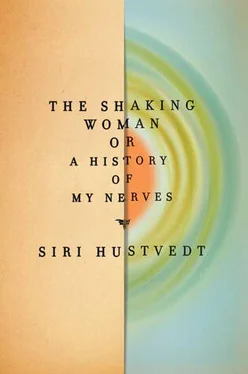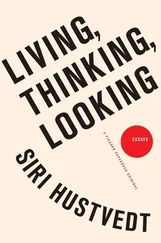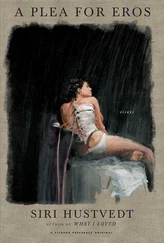Clearly, a self is much larger than the internal narrator. Around and beneath the island of that self-conscious storyteller is a vast sea of unconsciousness, of what we don’t know, will never know, or have forgotten. There is much in us we don’t control or will, but that doesn’t mean that making a narrative for ourselves is unimportant. In language we represent the passage of time as we sense it — the was, the is, the will be. We abstract and we think and we tell. We order our memories and link them together, and those disparate fragments gain an owner: the “I” of autobiography, who is no one without a “you.” For whom do we narrate, after all? Even when alone in our heads, there is a presumed other, the second person of our speech. Can a story ever be true? There will always be holes in it, the unarticulated breaches in our understanding, which we leap over with an “and” or a “then” or a “later.” But that is the route to coherence.
Coherence cannot eliminate ambiguity, however. Ambiguity is not quite one thing, not quite the other. It won’t fit into the pigeonhole, the neat box, the window frame, the encyclopedia. It is a formless object or feeling that can’t be placed. Ambiguity asks, Where is the border between this and that? Ambiguity does not obey logic. The logician says, “To tolerate contradiction is to be indifferent to truth.” Those particular philosophers like to play games of true and false. It is one or the other, never both. But ambiguity is inherently contradictory and insoluble, a bewildering truth of fogs and mists and the unrecognizable figure or phantom or memory or dream that cannot be contained or held in my hands because it is always flying away, and I can’t tell what it is or if it is anything at all. I chase it with words even though it won’t be captured and, every once in a while, I imagine I have come close to it. In May of 2006, I stood outside under a cloudless blue sky and started to speak about my father, who had been dead for over two years. As soon as I opened my mouth, I began to shake violently. I shook that day and then I shook again on other days. I am the shaking woman.
1. Owsei Temkin, The Falling Sickness: A History of Epilepsy from the Greeks to the Beginnings of Modern Neurology , 2nd ed. (Baltimore: Johns Hopkins Press, 1971), 36.
2. Frances Hill, The Salem Witch Trials Reader (New York: Da Capo Press, 2000), 59.
3. Temkin, Falling Sickness, 194.
4. Ibid., 225.
5. Diagnostic Statistical Manual of Mental Disorders, 4th ed. (Arlington, VA: American Psychiatric Association, 2000), 492–98. Hereafter DSM-IV.
6. Ibid., 493.
7. Carl W. Basil, Living Well with Epilepsy and Other Seizure Disorders (New York: Harper Resource, 2004), 73.
8. J. Lindsay Allet and Rachel E. Allet, “Somatoform Disorders in Neurological Practice,” Current Opinion in Psychiatry 19 (2006): 413–20.
9. “Introduction,” DSM-IV, xxx.
10. Peter Rudnytsky, Reading Psychoanalysis: Freud, Rank, Ferenczi, Groddeck (Ithaca: Cornell University Press, 2002), 90.
11. Robert J. Campbell, Campbell’s Psychiatric Dictionary, 8th ed. (Oxford: Oxford University Press, 2004), 189.
12. Sigmund Freud and Josef Breuer, Studies on Hysteria, trans. James Strachey (New York: Basic Books, 1957), 86.
13. Sigmund Freud, On Aphasia: A Critical Study, trans. E. Stengel (New York: International Universities Press, 1953), 55.
14. George Makari, Revolution in Mind: The Creation of Psychoanalysis (New York: HarperCollins, 2008), 70.
15. Freud and Breuer, Studies on Hysteria , 160–61.
16. Christopher G. Goetz, Michel Bonduelle, and Toby Gelfand, Charcot: Constructing Neurology (Oxford: Oxford University Press, 1995), 172–213.
17. Pierre Janet, The Major Symptoms of Hysteria: Fifteen Lectures Given in the Medical School of Harvard University (London: Macmillan, 1907), 324.
18. Ibid., 332.
19. Ibid., 325–26.
20. Ibid., 42.
21. Ibid., 38.
22. Eugene C. Toy and Debra Klamen, Case Files: Psychiatry (New York: McGraw-Hill, 2004), 401.
23. Todd Feinberg, Altered Egos: How the Brain Creates the Self (Oxford: Oxford University Press, 2001), 28.
24. Rita Charon, Narrative Medicine: Honoring the Stories of Illness (Oxford: Oxford University Press, 2006), 9.
25. J.-K. Zubieta et al., “Placebo Effects Mediated by Endogenous Opioid Activity on μ-Opioid Receptors,” Journal of Neuroscience 25 (2005): 7754–62.
26. Erika Kinetz, “Is Hysteria Real? Brain Images Say Yes,” New York Times, Sept. 26, 2006.
27. Sean A. Spence, “All in the Mind? The Neural Correlates of Unexplained Physical Symptoms,” Advances in Psychiatric Treatment 12 (2006): 357.
28. Goetz, Bonduelle, and Gelfand, Charcot, 192.
29. P. Vuilleumier et al., “Functional Neuroanatomical Correlates of Hysterical Sensorimotor Loss,” Brain 124, no. 6 (June 2001): 1077.
30. Quoted in Goetz, Bonduelle, Gelfand, Charcot, 187.
31. Freud and Breuer, Studies on Hysteria , 7.
32. Bertram G. Katzung, ed., Basic and Clinical Pharmacology , 9th ed. (New York: Lange Medical Books / McGraw-Hill, 2004), 156.
33. James L. McGaugh, Memory and Emotion: The Making of Lasting Memories (New York: Columbia University Press, 2003), 93.
34. Ibid., 107
35. Quoted in Daniel Brown, Alan W. Scheflin, and D. Corydon Hammond, Memory, Trauma, Treatment and the Law (New York: Norton, 1998), 95.
36. Françoise Davoine and Jean-Max Gaudillière, History Beyond Trauma, trans. Susan Fairfield (New York: Other Press, 2004), 179.
37. Onno van der Hart, Ellert R. S. Nijenhuis, and Kathy Steele, The Haunted Self: Structural Dissociation and the Treatment of Chronic Trauma (New York: Norton, 2006).
38. Ian Hacking, Rewriting the Soul: Multiple Personality and the Sciences of Memory (Princeton, NJ: Princeton University Press, 1995), 21.
39. Janet, Major Symptoms, 131.
40. Ibid., 172.
41. Three Short Novels of Dostoyevsky, trans. Constance Garnett, ed. Avrahm Yarmolinsky (New York: Doubleday, 1960), 15.
42. Hans Christian Andersen, “The Shadow,” in Fairy Tales, vol. 2, trans. R. P. Keigwin (Odense, Denmark: Hans Reitzels Forlag, 1985), 188.
43. Klaus Podoll and Markus Dahlem, http://www.migraineaura.org. See also P. Brugger, M. Regard, and T. Landis, “Illusory Replication of One’s Own Body: Phenomenology and Classification of Autoscopic Phenomena,” Cognitive Neuropsychiatry 2, no. 1 (1997): 19–38.
44. Todd Feinberg and Raymond M. Shapiro, “Misidentification-Reduplication and the Right Hemisphere,” Neuropsychiatry, Neuropsychology and Behavioral Neurology (2, no. 1): 39–48.
45. Feinberg, Altered Egos, 74–75.
46. Jacques Lacan, “The Mirror Stage as Formative of the I Function,” in Écrits, trans. Bruce Fink (New York: Norton, 2006), 75–81.
47. Maurice Merleau-Ponty, “The Child’s Relation to Others,” The Primacy of Perception, trans. William Cobb (Chicago: Northwestern University Press, 1964), 117.
48. Shaun Gallagher, How the Body Shapes the Mind (Oxford: Clarendon Press, 2005), 26.
49. Roger W. Sperry, “Some Effects of Disconnecting the Cerebral Hemispheres,” Bioscience Reports 2, no. 5 (May 1982): 267.
50. Dahlia W. Zaidel, “A View of the World from a Split-Brain Perspective,” http://cogprints.org/920/0/critchelyf.pdf.
Читать дальше












